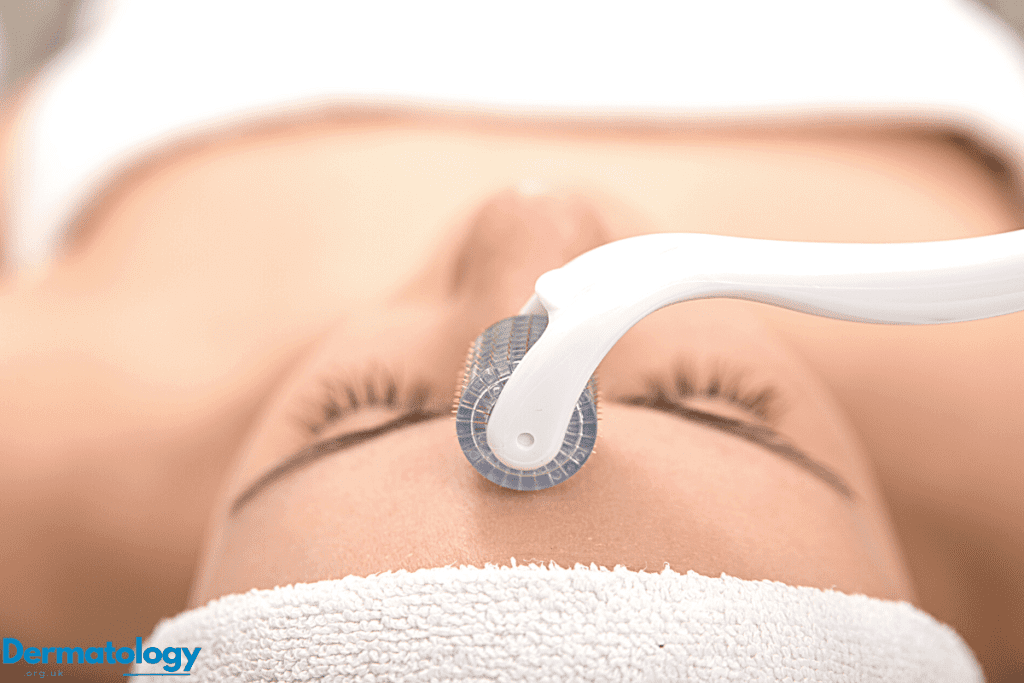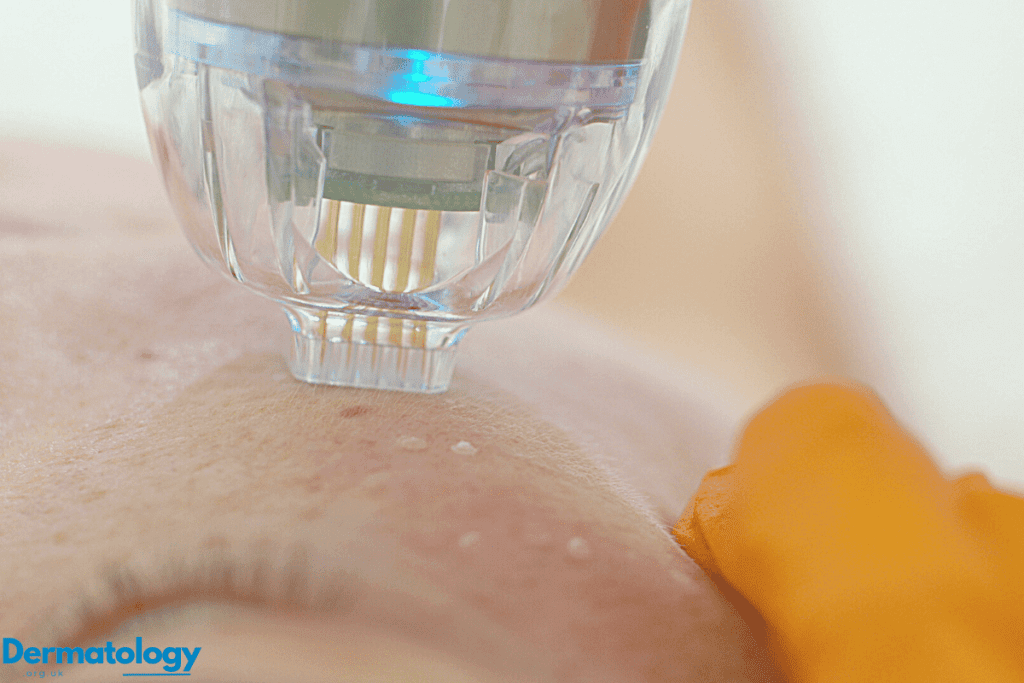You’ve probably heard the buzz about microneedling, the skin-rejuvenating treatment making waves in the beauty world. Microneedling, often touted as a ‘miracle’ for your skin, is a minimally invasive treatment designed to stimulate your skin’s natural ability to heal itself. It’s a game-changer in skincare, promising to reduce the appearance of scars, sagging skin, wrinkles, and even stretch marks.
Table of Contents
What Is Microneedling?
Microneedling, or collagen induction therapy, involves puncturing the skin with tiny, sterile needles, which are used as a beneficial alternative to topical treatments. These create controlled micro-injuries, triggering your skin’s healing response and leading to increased collagen and elastin production.
Primarily employed in improving skin texture, microneedling reduces signs of aging like wrinkles, diminishes scars and stretch marks, and can reduce the appearance of sun damage. It’s typically performed by a licensed professional who uses a dermaroller or an automated device on the top layers of the skin.
The derma roller is a handheld device embedded with tiny needles, carefully moved over the skin’s surface in a brushing motion. Automated devices incorporate a cluster of fine needles that puncture the skin vertically.
Given its effectiveness and minimal downtime, microneedling has become a go-to skin rejuvenation treatment. However, proceed with caution if you’re dealing with active skin infections, acne scars, or are pregnant, as microneedling may not be suitable under these conditions.
Benefits of Microneedling Treatment
A microneedling treatment can provide a list of benefits depending on your current skin condition. First, it improves skin texture, as tiny needle punctures stimulate your skin to renew itself, resulting in silkier, smoother skin. It can also reduce signs of aging thanks to less dry skin and an improved skin tone.
It assists in collagen production which is responsible for filling in fine lines and wrinkles and diminishing scars and stretch marks. By encouraging the growth of new skin tissue, it effectively lightens blemishes. Besides these, it increases the absorption of skincare products.
Post-treatment, your skin better absorbs serums and creams, making your skincare regimen more effective. Lastly, it suits diverse skin types. Typically, microneedling shows excellent results on different skin textures and tones.
The Microneedling Treatment Procedure

Following your decision to undergo microneedling treatment and understanding its benefits, you should look deeper into the specifics of the procedure. You’ll appreciate its methodical and carefully designed process that contributes to its effectiveness as a skin rejuvenation method.
Initial Consultation and Assessment
To ensure maximum benefits without any hiccups, the procedure begins with the all-important initial consultation. Without exception, highly professional clinics conduct a thorough skin analysis as the initial step of your microneedling journey.
Here, a skin expert or dermatologist analyzes your skin type, skin condition, objectives, and medical history. Any existing skin conditions, such as active acne, keloids, or any unique skin anomalies, are taken into account.
Based on this comprehensive evaluation, a certified professional will recommend the most suitable type of microneedling treatment for you, as well as the frequency of sessions needed to achieve your desired results.
The Microneedling Process
With the initial evaluation complete, the actual microneedling process begins. Usually, the treatment starts with cleaning your skin and then applying a topical anesthetic. After about 30 minutes, once the anesthetic takes effect, the practitioner uses a microneedling device across your skin.
This device, having multiple tiny needles, creates micro-punctures in the skin. This triggers the skin’s healing response, boosting collagen and elastin production. After the microneedling, a soothing serum or a healing mask is typically applied to calm the skin.
The whole process typically takes less than an hour depending on the size of the area. Bear in mind that your skin may appear red and feel slightly sensitive post-treatment – a natural and expected response of the skin. Look forward to the benefits of microneedling that tend to start surfacing in about 24 hours to a week with noticeable improvements in your skin’s texture, firmness, and overall appearance.
How To Prepare For Treatment
As you prepare for your first treatment, a few steps can optimize your skin’s response to the treatment and enhance the results. First, stop using any retinoid products a week prior to treatment, as these can excessively thin your skin and increase the chance of irritation.
Additionally, any form of skin inflammation, such as sunburn, needs to be fully healed before the treatment. Avoid excessive sun exposure for at least 48 hours before your treatment in order to minimize hyperpigmentation risks.
Regularly hydrate your skin, aiming for at least two liters of water per day. This will help maintain your skin’s health and resilience. In the week preceding your session, focus on maintaining a healthy diet and limit your intake of alcohol, as it can dry out your skin.
Lastly, always consult with your skincare professional about any specific products to use or avoid in the lead-up to your treatment, and remember to voice any concerns or queries you may have in order to ensure a successful and comfortable microneedling experience.
Microneedling Aftercare

Your microneedling aftercare routine will be a major influence on the effectiveness of your results from treatment. After all, combining microneedling with a good skincare regime enhances your treated skin’s recovery. First, avoid heavy makeup during the first 24-48 hours, letting your skin breathe and recover better.
Second, skip direct sunlight and tanning beds for the first week or two, as your skin is susceptible to damage and discoloration. Opt for protective clothing and sunblock with an SPF of 30 or more after this period. Third, refrain from intense workouts or saunas that cause sweating because it aggravates the skin.
For the first week, clean your skin with a mild cleanser approved by a skincare professional, and avoid exfoliating or active skincare ingredients like retinoids, vitamin C, or alpha/beta hydroxy acids. Apply a soothing moisturizer generously to keep your skin hydrated. Hyaluronic acid is a great choice.
Remember, it’s normal to notice skin peeling, and you must resist physically exfoliating it. Drink plenty of water, avoid alcohol, and ensure a balanced diet high in protein for optimal skin healing.
Common Side Effects
Following the microneedling skin-rejuvenating treatment, you might encounter some side effects. For 24 to 48 hours after treatment, your skin may resemble a sunburn’s appearance, as you will likely notice skin redness.
Dryness and irritation often partners with this redness as your skin adapts to increased collagen and elastin production. Tiny pricks from microneedling might make your skin more sensitive, causing itchiness or discomfort. Additionally, skin swelling isn’t uncommon. It’s typically mild and subsides after a few days.
But remember, immediate reactions aren’t limited to external signs. Some individuals complain of a headache after treatment. Since microneedling works by causing skin injury and subsequent healing, it might bring you some minor pain.
Skin infection constitutes a rare but possible side effect. Strictly adhering to post-treatment skincare reduces this risk. If you observe skin peeling or pus, it might indicate an infection, and you should consult a healthcare professional immediately.
Bear in mind that side effects generally resolve themselves in a few days, making way for the much-awaited treatment benefits. Side effects are typically part of the process, not a hindrance, seen as your skin’s response to the rejuvenation technique. It paints the picture of an active healing and regeneration process.
Microneedling Cost UK
The exact price of a single microneedling session varies considerably based on your geographical location and the specialist clinic’s reputation. Generally, the typical expense ranges from £80 to £560 per session, with most individuals requiring multiple sessions for optimal results.
As an example, if your skin condition calls for a basic three-session treatment, you’re looking at an overall cost between £240 and £1700. Remember, this cost estimate excludes any additional costs like consultation fees, post-treatment care products, or revised sessions in case of complex skin conditions.
Location and the professional you seek will also influence the price point. It’s crucial to confirm all the associated costs with the provider before starting the treatment to avoid surprises down the line.
Finding a Quality Provider
The quality of the provider plays a considerable role in the effectiveness of microneedling treatments. A licensed and experienced professional assures procedural safety and desired outcomes. Hence, researching your provider’s credentials and their patient testimonials becomes the top priority.
Maintaining a strong focus on credentials, experience, patient satisfaction, and MHRA -approved equipment ensures you invest your time and resources in a qualified and skilled provider. Remember, the right practitioner not only has a dramatic effect on your results but also reduces possible side effects and recovery time. Always verify your provider’s qualifications and experience before entrusting your skin’s health to them.
FAQ
How effective is microneedling?
Microneedling is effective in reducing the appearance of scars, wrinkles, and large pores by promoting collagen production in the skin. The effects can be seen after several sessions, with gradual improvement over time.
What is negative about microneedling?
Negative aspects of microneedling include potential side effects such as redness, irritation, and in some cases, infection or scarring, particularly if not performed by a qualified professional. It also requires multiple sessions and maintenance treatments for sustained results.
Is Microneedling Better than Botox?
Microneedling and Botox serve different purposes; microneedling is aimed at improving skin texture and firmness through collagen production, while Botox is primarily used to reduce the appearance of facial wrinkles by temporarily paralyzing muscles. The choice between the two depends on the specific skin concerns and desired outcomes.
How long does microneedling last for?
The results of microneedling can last for 3 to 5 months, but longevity varies based on the individual’s skin condition, the severity of the issues being treated, and the number of sessions undergone. Regular maintenance treatments are recommended to sustain the benefits.
